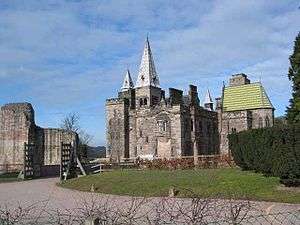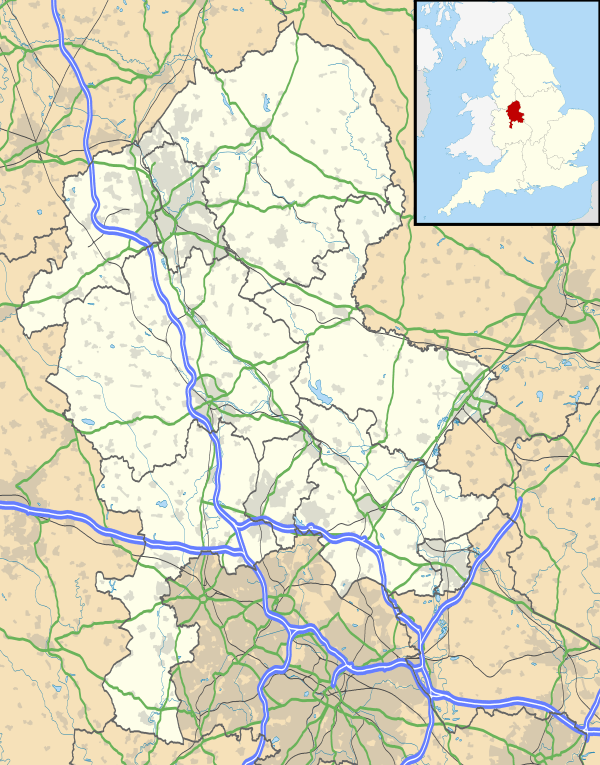Alton Castle
| Alton Castle | |
|---|---|
| Alton, Staffordshire | |
 | |
 Alton Castle | |
| Coordinates | grid reference SK074425 |
| Type | Masonry castle |
| Site history | |
| Built |
12th century; present building: mid-19th-century. |
| Built by |
Bertram de Verdun; present castle built by John Talbot, 16th Earl of Shrewsbury |
Alton Castle is a Gothic-revival castle, located on a hill above the Churnet Valley, in the village of Alton, Staffordshire. The site has been fortified since Saxon times, with the original castle dating from the 12th century. The current castle was constructed in the mid-19th century by John Talbot, 16th Earl of Shrewsbury, of near by Alton Towers. Since 1967 the castle has been designated a Grade I listed building.[1] It is also a scheduled ancient monument.[2]
History
Alton Castle was founded by Bertram de Verdon and built on a rocky precipice overlooking the River Churnet in the 12th century,, however the site had been fortified since Saxon times.[3] The castle is also known as or referred to in historical documents as Alton, Alverton or Aulton. The 12th-century castle was substantially reconstructed during the 15th century and subsequently was damaged during the Civil War.
Since 1442, the castle was in the possession of the Earls of Shrewsbury, who from the beginning of the 19th-century made their home at nearby Alton Towers. By the mid-19th-Century the castle was mostly in ruins.[3] John Talbot, 16th Earl of Shrewsbury, commissioned Catholic architect Augustus Pugin, who was already working for the Earl at Alton Towers, to construct a new gothic castle/country house on the site.[4][1] Most of the 12th-century ruins were demolished to make way for the new building which was designed to look like a French or German medieval castle. The earl also commissioned Pugin to develop the surrounding area on castle hill. A "replica of a medieval hospital, a guildhall and presbytery" were constructed; dedicated to St. John the Baptist, the buildings served as a church and hospital (almshouses) and were designed to provide and care for the poor for of the parish. The church was also used as a school for local poor children.[3]
It is unclear why the 16th Earl had the castle rebuilt. It may have been intended for the Earl's cousin and eventual successor, Bertram Talbot (17th Earl of Shrewsbury); or it may have been intended as a Dower House for the Earl's wife, if he should predecease her. Towards the end of the castle's construction, the earl suggested the castle could be a home for priests, but Pugin was "vehemently against the idea".[3]
The site was taken over by the Sisters of Mercy in 1855 and the presbytery became their convent. The castle remained a private residence until 1919 when the Sisters of Mercy bought it for £3,500 to extend their boarding school. The school closed in 1989 and the castle was left empty until in 1996.[5]
In 1996 it was established by the Archdiocese of Birmingham as a Catholic Youth Retreat Centre.[6]
Present Day
Alton Castle is now in its 20th year as a residential youth centre and UK registered charity working with children aged between 9 and 13 years. Over 8,000 children visit the Castle each year, mainly with schools, but also from other children’s organisations such as youth groups and charities who work with children with disabilities. Some of the children have suffered disadvantages, including disability, and many come from inner city areas of social and economic deprivation.
Alton Castle aims to raise self-esteem, to strengthen and build friendships, and to help each child realise their potential as human beings. The children participate in a variety of activities during their stay including mountain biking, trekking, archery, rockclimbing and survival. [7]
See also
- Alton Towers - Nearby Gothic-revival stately home; also formerly owned by the Earls of Shrewsbury.
- Alton Towers Theme park - Theme Park built in the grounds of the former stately home.
- List of Grade I listed buildings in Staffordshire
References
- 1 2 "The Castle, Alton", The National Heritage List for England, English Heritage, 2011, retrieved 8 May 2011
- ↑ "Alton Castle", The National Heritage List for England, English Heritage, 2011, retrieved 8 May 2011
- 1 2 3 4 Alton Towers Heritage: The 16th Earl and Castle Hill
- ↑ "Alton Castle". CastleUK.Net. Archived from the original on 3 January 2008. Retrieved 2007-11-29.
- ↑ "Alton Castle". Staffordshire County Council. Retrieved 2007-11-29.
- ↑ "Alton Castle". Gabriel Education Trust. Archived from the original on 16 October 2007. Retrieved 2007-11-29.
- ↑ Paul Connor. "Alton Castle Official Website". Alton Castle.
Michael Fisher, 'Gothic For Ever! - Pugin, Lord Shrewsbury, and the Catholic Revival in England', Spire Books, 2012.
Michael Fisher, 'Hospital of St. John, and Alton Castle', A.W.N. Pugin Guides, Urban Vision, N. Staffs., 2012
External links
- "Alton Castle". Webb Aviation. Retrieved 2007-11-29.
- "Alton Castle". Pugin Society. Archived from the original on 10 November 2007. Retrieved 2007-11-29.
Coordinates: 52°58′47″N 1°53′28″W / 52.9798°N 1.8912°W